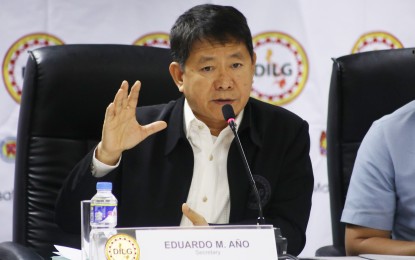
DILG Secretary Eduardo Año. (File photo)
MANILA – Department of the Interior and Local Government (DILG) Secretary Eduardo Año said the government's contact tracing capability for coronavirus disease 2019 (Covid-19) patients or carriers has now improved to 96 percent.
"Malaki ang improvement ng ating contact tracing (There is a significant improvement in our contact tracing capabilities)," Año said in a Palace briefing Monday.
With this, he said the country's capability to contain the Covid-19 threat also improved.
"Because of contact tracing, nag-improve ang ating sitwasyon [Because of improved contact tracing, our overall situation has improved)," Año added.
However, Metro Manila's contact tracing ability remains at 76 percent, or 20 percent lower than the national average.
Año attributed this decline to the government's observance of data privacy laws.
Meanwhile, Año said the purpose of lifting the requirement for quarantine passes and easing restrictions is to be able to slowly restart our economy from the more than two-month enhanced community quarantine imposed in many areas of the country without compromising health protocols.
“The country’s economy is hurting badly, many businesses have closed down and our people are finding it difficult to fend for their families have no source of income for the past two months. We need to reopen the economy without setting aside health protocols if we want to survive this pandemic as a people,” he said.
Año said the easing of restrictions in Metro Manila and in other areas in the country means those under GCQ will now see many industries opening up to its 100 percent functionality, but this does not mean that everything is back to normal.
“Although some restrictions will be relaxed, this does not mean that we can all go out leisurely and go about our day. Alamin pa rin natin kung ang dahilan ba ng inyong paglabas ay essential pa rin at hindi para mamasyal lang (Let us determine whether our purpose for going out is essential and not just to roam around),” he said.
He, however, said, LGUs may still require quarantine passes in “high-risk” barangays known as critical zones and buffer zones that they are monitoring and doing contact-tracing activities.
“The general rule is hindi na kailangan ng quarantine pass pero may authority pa rin ang LGU na mag-impose ng lockdown at mag-require ng quarantine pass sa mga barangay or subdivision na sa assessment nila ay high-risk pa rin (there is no need for quarantine pass but the LGUs can impose a lockdown and require a quarantine pass for barangays or subdivisions which appear as high-risk areas based on their assessment). Mayors should, therefore, announce through their official social media accounts or whatever means kung required pa rin ang quarantine pass sa ilang lugar sa kanila (if quarantine pass is required in their areas),” he said.
DILG Undersecretary and spokesperson Jonathan Malaya said going across provinces and other regions across the country would still require travel passes which can be applied at the help desk of the nearest Philippine National Police (PNP) station provided he has a medical certificate from the Municipal/City Health Office.
Exempted from travel passes are those who need to cross provincial and regional borders for work-related matters.
“In such cases, they only need to present their company ID or documents from their office or company justifying the reason for such travel,” he said.
Malaya said the Philippine National Police (PNP) will also set up random checkpoints across Metro Manila but will impose stricter control on regional and provincial borders.
The PNP’s Highway Patrol Group (PNP-HPG) will conduct random and mobile checkpoints through its “Oplan Habol” and “Oplan Sita” where motorcycle-riding patrollers roam around to check for “unauthorized persons outside residence” (UPOR) or violators in private vehicles, different from the usual fixed checkpoints.
“Depending on the discretion of the PNP commanders on the ground, we can have lesser fixed checkpoints and adjust the mobile checkpoints,” he said. (PNA)
